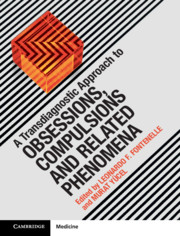Book contents
- A Transdiagnostic Approach to Obsessions, Compulsions and Related Phenomena
- Reviews
- A Transdiagnostic Approach to Obsessions, Compulsions and Related Phenomena
- Copyright page
- Dedication
- Contents
- Contributors
- Foreword
- Acknowledgments
- Section 1 Theoretical Foundations of Obsessive-Compulsive and Related Disorders
- Section 2 Practical Aspects of Obsessive-Compulsive Disorder
- 10 Epidemiology of Obsessive-Compulsive Disorder
- 11 Symptoms, Diagnosis and Specifiers of Obsessive-Compulsive Disorder
- 12 The Natural History of Obsessive-Compulsive Disorder across the Lifespan
- 13 Sub-Diagnostic Obsessive-Compulsive Symptoms
- 14 Assessment Instruments for Obsessive-Compulsive Disorder
- 15 Pharmacological Treatments for Obsessive-Compulsive and Related Disorders: A Transdiagnostic Perspective
- 16 Psychological Treatment of Obsessive-Compulsive Disorder: Efficacy, Mechanisms and Transdiagnostic Implications
- 17 Innovative Cognitive Behavioral Treatments for Obsessive-Compulsive Disorder
- 18 Drug Augmentation Strategies for Treatment-Resistant Obsessive-Compulsive and Related Disorders
- 19 Integrating Cognitive Behavioral Therapy and Medications for the Treatment of Obsessive-Compulsive Disorder
- 20 Deep Brain Stimulation, Transcranial Magnetic Stimulation and Transcranial Direct Current Stimulation for Obsessive-Compulsive Disorder
- 21 Neurosurgery for Obsessive-Compulsive Disorder: Indications and Procedures
- 22 Alternative Treatments for Obsessive-Compulsive Disorder: Nutraceuticals and Lifestyle Interventions
- Section 3 Practical Aspects of Other Obsessive-Compulsive Related Disorders
- Index
- References
15 - Pharmacological Treatments for Obsessive-Compulsive and Related Disorders: A Transdiagnostic Perspective
from Section 2 - Practical Aspects of Obsessive-Compulsive Disorder
Published online by Cambridge University Press: 14 December 2018
- A Transdiagnostic Approach to Obsessions, Compulsions and Related Phenomena
- Reviews
- A Transdiagnostic Approach to Obsessions, Compulsions and Related Phenomena
- Copyright page
- Dedication
- Contents
- Contributors
- Foreword
- Acknowledgments
- Section 1 Theoretical Foundations of Obsessive-Compulsive and Related Disorders
- Section 2 Practical Aspects of Obsessive-Compulsive Disorder
- 10 Epidemiology of Obsessive-Compulsive Disorder
- 11 Symptoms, Diagnosis and Specifiers of Obsessive-Compulsive Disorder
- 12 The Natural History of Obsessive-Compulsive Disorder across the Lifespan
- 13 Sub-Diagnostic Obsessive-Compulsive Symptoms
- 14 Assessment Instruments for Obsessive-Compulsive Disorder
- 15 Pharmacological Treatments for Obsessive-Compulsive and Related Disorders: A Transdiagnostic Perspective
- 16 Psychological Treatment of Obsessive-Compulsive Disorder: Efficacy, Mechanisms and Transdiagnostic Implications
- 17 Innovative Cognitive Behavioral Treatments for Obsessive-Compulsive Disorder
- 18 Drug Augmentation Strategies for Treatment-Resistant Obsessive-Compulsive and Related Disorders
- 19 Integrating Cognitive Behavioral Therapy and Medications for the Treatment of Obsessive-Compulsive Disorder
- 20 Deep Brain Stimulation, Transcranial Magnetic Stimulation and Transcranial Direct Current Stimulation for Obsessive-Compulsive Disorder
- 21 Neurosurgery for Obsessive-Compulsive Disorder: Indications and Procedures
- 22 Alternative Treatments for Obsessive-Compulsive Disorder: Nutraceuticals and Lifestyle Interventions
- Section 3 Practical Aspects of Other Obsessive-Compulsive Related Disorders
- Index
- References
- Type
- Chapter
- Information
- Publisher: Cambridge University PressPrint publication year: 2019

